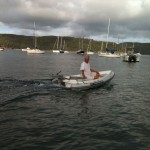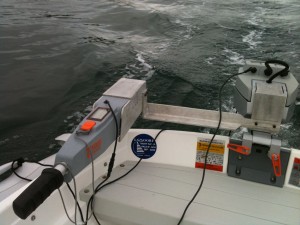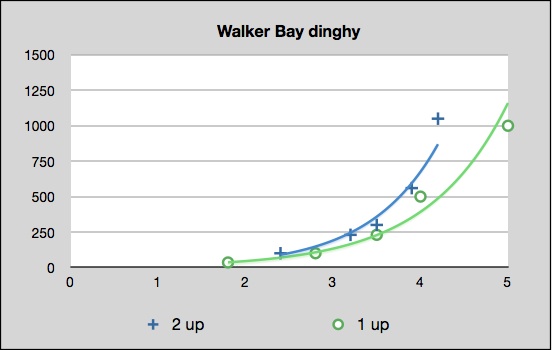I’ve been wanting to try out a Walker Bay dinghy—they claim to be easily rowed and that should augur well for use with a Travel 1003. You’ll see we also trial a extension/offset device for the tiller which we borrowed from David who you may remember from the Sea-eagle kayak installation.
Lionel finds the Walker Bay is better balanced solo when he sits on the middle seat and from this position an extended/offset tiller is a real handy device. It also makes reading of the display more accessible with just a quick glance to the side to check speed or range. The control cable is designed for direct coupling of the tiller to the 1003 frame and needs an extension for this kind of use. A cable seconded from an Ultralight kayak motor is well suited to this—its about 1.5 metres long, but the only one I had available was a 5m cable for a Cruise 4. Longer than we needed and you’ll see the cable loops in some of the photos.
The extension/offset tiller device was fabricated out of aluminium by David Box to make steering of his SeaEagle kayak easier. And since then he has set up a hydraulic steering and tilting mechanism—and we’ll take a closer look at that in another post coming soon.
You can see the experimental extension device fits neatly into the Travel 1003 head and at the other it offers the same locking mechanism to receive the tiller.
Here’s some performance figures for the Walker Bay. Top speed was 5 knots with only me in the dinghy and positioned well forward, and 4.2 knots with 2 up. We tried different seating positions and the most enjoyable was with me sitting in the bow seat facing the stern and Lionel on the stern seat facing forward. Having the tiller offset device was helpful when sitting in the back seat because it made it easy to sit in the centre and keep the boat balanced.
Contrast with an inflatable dinghy such as a Zodiac where the central location of the tiller is good because its comfortable to sit on the side tube and operate the motor easily from there. The display is also in a good position for viewing.






Glad someone posted about the combo of the WB dinghy with the torqeedo 1003; I’m seriously considering the purchase of this combo. Great chart. One piece of missing info that I’m looking for: Which Walker Bay dinghy is that? They make an 8′ and a 10′. I’m wondering if the 10′ would produce better speeds due to it’s longer hull (even though it’s a bit heavier).
Hi Bryan, I’m pretty sure it is the 8ft one, especially when looking at the photos. I expect you’re right that the 10ft on would produce better speed, not only from longer hull, but also because it would not sit as deep in the water. I expect the extra speed would be minimal.
Cheers
Chris
Hi, I know this is somewhat of an old post now but I had some questions.
It seems like you were going to say some things but then the article stopped. You talked and seating position and speed and that was it. On your graph you don’t label the axes so I don’t know what they are. the x is speed I imagine but what is the y axis ? Some insight into range would be helpful. Thanks.
Hi Chris, it is an old entry and I’m not sure what I might say further now that some time has gone by. The y axis is watts. You can deduce range from the chart. For example, say you are one up in the dinghy and want to travel at 3 knots. The power needed would be about 125 watts. If you have a 915 watthr battery that would give you 7.3 hours of operation. Say 7 hours. At 3 knots that is 21 nautical mile range.